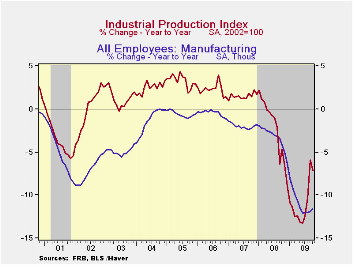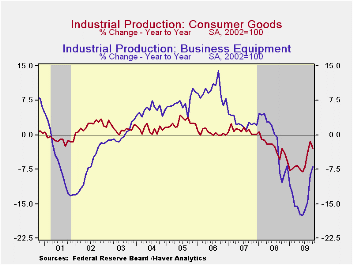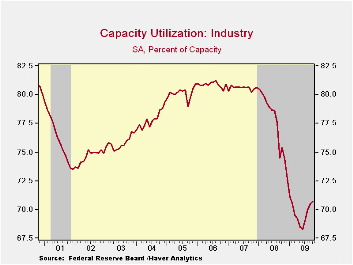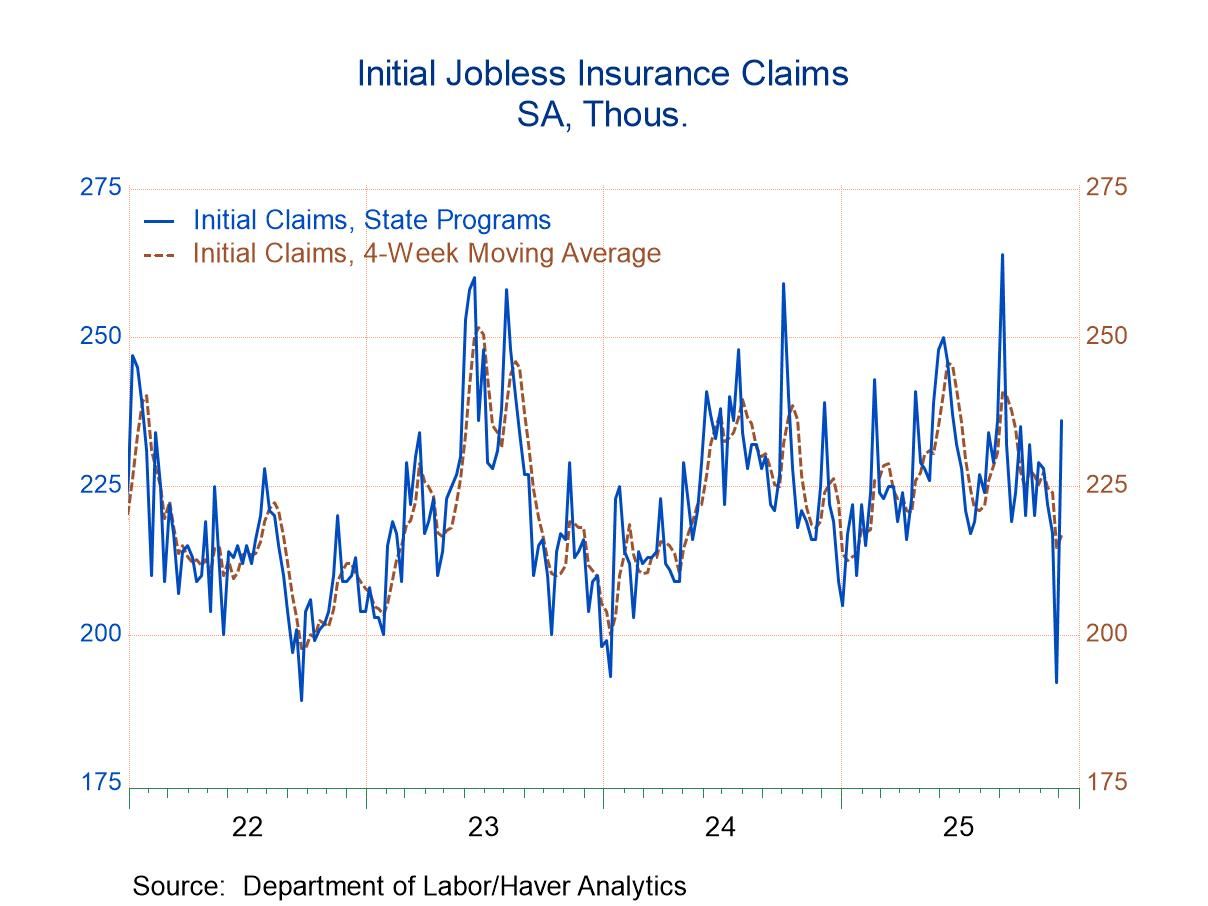 Global| Nov 17 2009
Global| Nov 17 2009Factory Production Unchanged As Gains Of Prior Three Months Stall
by:Tom Moeller
|in:Economy in Brief
Summary
The earlier recovery in industrial production stalled last month after smart, unrevised increases during the summer. The October reading of no change in output also fell short of Consensus expectations for a 0.4% gain. The weakening [...]
 The
earlier
recovery in industrial production stalled last month after smart,
unrevised increases during the summer. The October reading of no change
in output also fell short of Consensus expectations for a 0.4% gain.
The weakening from earlier increases was widespread amongst sectors.
Output of consumer goods was unchanged after strong gains during the
prior three months. A 1.6% (-11.6% y/y) decline in motor vehicle output
led the weakening. Output of computers, video & audio
equipment also sagged by 0.3% (-8.2% y/y) after three months of
increase.
The
earlier
recovery in industrial production stalled last month after smart,
unrevised increases during the summer. The October reading of no change
in output also fell short of Consensus expectations for a 0.4% gain.
The weakening from earlier increases was widespread amongst sectors.
Output of consumer goods was unchanged after strong gains during the
prior three months. A 1.6% (-11.6% y/y) decline in motor vehicle output
led the weakening. Output of computers, video & audio
equipment also sagged by 0.3% (-8.2% y/y) after three months of
increase.
 Outside of
the auto &
high-tech sectors production ticked 0.1% higher during October (-6.9%
y/y) following three months of firm gain. The uptick was led
by a 3.6% (-18.8% y/y) jump in primary metals output, a 1.3% (-15.6%
y/y) rise in textile mills production and a 1.4% (-5.5% y/y) rise in
paper output. Working the other way, however, were widespread
declines. Furniture & appliance output continued to slide and
posted a 1.9% (-20.1% y/y) decline. Apparel output reversed two months
of increase with a 0.8% (-15.0% y/y) decline while petroleum &
coal output fell 2.9% (-5.0% y/y). Output of business equipment fell
0.3% (-6.8% y/y) with a 0.9% (-12.4% y/y) drop in electrical equipment
output. Reflecting continued weakness in nonresidential building
activity, output of construction supplies fell 1.2% (-17.0% y/y), about
as it did in September.
Outside of
the auto &
high-tech sectors production ticked 0.1% higher during October (-6.9%
y/y) following three months of firm gain. The uptick was led
by a 3.6% (-18.8% y/y) jump in primary metals output, a 1.3% (-15.6%
y/y) rise in textile mills production and a 1.4% (-5.5% y/y) rise in
paper output. Working the other way, however, were widespread
declines. Furniture & appliance output continued to slide and
posted a 1.9% (-20.1% y/y) decline. Apparel output reversed two months
of increase with a 0.8% (-15.0% y/y) decline while petroleum &
coal output fell 2.9% (-5.0% y/y). Output of business equipment fell
0.3% (-6.8% y/y) with a 0.9% (-12.4% y/y) drop in electrical equipment
output. Reflecting continued weakness in nonresidential building
activity, output of construction supplies fell 1.2% (-17.0% y/y), about
as it did in September.
 Despite
the weakening of output,
utilization of capacity ticked higher to 70.7%. The increase was caused
by an estimated 0.1% (-0.8% y/y) decline in industry capacity.
Utilization in the factory sector held steady at 67.9% though it was up
from the June low of 65.2%. Utilization in the primary metals are has
risen sharply to 56.9% with the rebound in output. There's also been a
rise in utilization in the machinery area but it's down most
elsewhere.
Despite
the weakening of output,
utilization of capacity ticked higher to 70.7%. The increase was caused
by an estimated 0.1% (-0.8% y/y) decline in industry capacity.
Utilization in the factory sector held steady at 67.9% though it was up
from the June low of 65.2%. Utilization in the primary metals are has
risen sharply to 56.9% with the rebound in output. There's also been a
rise in utilization in the machinery area but it's down most
elsewhere.
The industrial production data are available in Haver's USECON database.
Policy Challenges for the Federal Reserve is yesterday's speech by Fed Vice-Chairman Donald L. Kohn and it can be found here .
How Will Unemployment Fare Following the Recession? from the Federal Reserve Bank of Kansas City is available here.| INDUSTRIAL PRODUCTION (SA,%) | October | September | August | Y/Y | 2008 | 2007 | 2006 |
|---|---|---|---|---|---|---|---|
| Total Output | 0.0 | 0.7 | 1.2 | -7.2 | -2.2 | 1.5 | 2.3 |
| Manufacturing | -0.1 | 0.7 | 1.5 | -7.9 | -3.2 | 1.4 | 2.5 |
| Consumer Goods | 0.0 | 1.3 | 1.6 | -2.9 | -2.6 | 0.9 | 0.4 |
| Business Equipment | -0.3 | -0.4 | 1.1 | -6.8 | -1.1 | 2.7 | 9.4 |
| Construction Supplies | -1.2 | -1.1 | 0.7 | -17.0 | -6.3 | -2.0 | 2.3 |
| Utilities | 1.6 | -0.2 | 0.8 | -2.1 | 0.3 | 3.4 | -0.6 |
| Capacity Utilization | 70.7 | 70.5 | 70.0 | 75.4 (Oct. '08) | 77.5 | 80.6 | 80.9 |
Tom Moeller
AuthorMore in Author Profile »Prior to joining Haver Analytics in 2000, Mr. Moeller worked as the Economist at Chancellor Capital Management from 1985 to 1999. There, he developed comprehensive economic forecasts and interpreted economic data for equity and fixed income portfolio managers. Also at Chancellor, Mr. Moeller worked as an equity analyst and was responsible for researching and rating companies in the economically sensitive automobile and housing industries for investment in Chancellor’s equity portfolio. Prior to joining Chancellor, Mr. Moeller was an Economist at Citibank from 1979 to 1984. He also analyzed pricing behavior in the metals industry for the Council on Wage and Price Stability in Washington, D.C. In 1999, Mr. Moeller received the award for most accurate forecast from the Forecasters' Club of New York. From 1990 to 1992 he was President of the New York Association for Business Economists. Mr. Moeller earned an M.B.A. in Finance from Fordham University, where he graduated in 1987. He holds a Bachelor of Arts in Economics from George Washington University.






